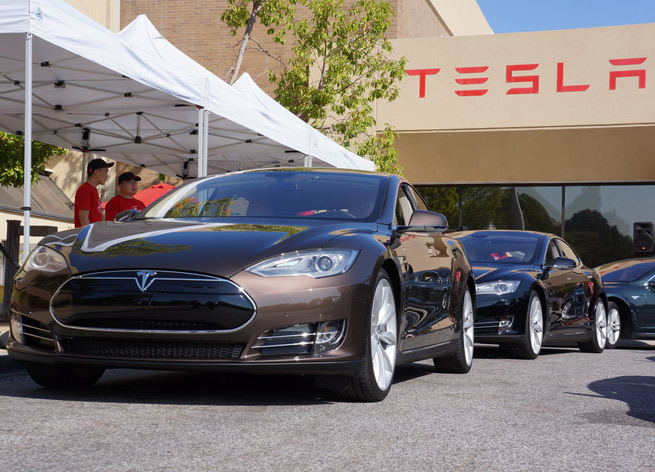When designing the Tesla Model S, Elon Musk wanted an electric motor that had the same horsepower as the most powerful internal combustion engine but with nearly-instantaneous torque. And he wanted it to be the size of a watermelon. Engine manufacturers told him this couldn’t be done. So the Tesla CEO decided to build his own motor. The earlier versions of this had a hand-wound stator which increased winding density to help eliminate resistance and increase peak torque. Later versions of the stators were built by robots.
Musk made the same decision with practically every other component of the Tesla — including the power electronics and other elements of the drivetrain. For him, there could be no compromises in design and functionality. That is why almost every component of the Tesla Model S is produced at its factory in Fremont, Calif.
When you drive a Model S, you can see the results. The car literally seems to fly. It picks up acceleration like a spaceship shifting into warp speed. The car is eerily quiet, comfortable, and elegant. It is a completely different driving experience than the cars we are used to. There is no engine to start, gears to shift, or oil to replace. The brakes don’t wear out because you hardly use them. The Tesla regenerative-braking system charges the car as it slows.
The best part is that the Tesla generates no exhaust fumes to pollute the environment. And if your house has solar panels as mine does, there is a very low fuel cost.
My only complaint after owning my Model S for a year is that I now have a hard time driving conventional gas-powered vehicles. They seem clunky and crude. It’s like going back to cassette tapes after using iPods and iPhones. I forget to switch the engine on, find the noise deafening, and feel the jerks when the gears change.
I was not surprised when, last year, Consumer Reports said the Model S was the best car they had ever tested and that this year they named it their best overall “Top Pick” — giving it their highest scores in performance, safety, and reliability. My experience has been the same. After a few initial repairs, the car has had absolutely no problems. It doesn’t need an oil change or maintenance, so I haven’t even had to visit the dealership. I love getting the automatic software upgrades — which add the same types of features as when we update our iPhones. When is the last time that your internal-combustion vehicle had a feature upgrade?
Yes, I know I am biased and seem like a Tesla “fanboy.” This is because I see the future of the automotive industry and a way to reduce our dependence on environment-destroying fossil fuels. Tesla has now proven the viability and superiority of electric vehicles. Along the way, it has had to battle skeptics, short-sellers, and even the press. Last year, for example, the New York Times had to issue an apology of sorts by admitting that one of its reporters had “problems with precision and judgment.” It had published a deeply flawed review of the Model S.
Tesla’s latest announcement of the Gigafactory will cause another big leap forward. The company announced plans to build a gigantic $5 billion factory that produces 35GWh of battery storage a year — which is more than all the lithium-ion batteries produced worldwide in 2013. Tesla expects that when it starts ramping up production in 2017, prices for batteries will be 30 percent lower than they are today. This is not an unrealistic assumption because battery prices have been dropping at even faster rates. An analysis by Deutsche Bank showed that laptop battery prices fell from $2,000 to $250 over a 15-year period, and lithium ion battery prices fell from $650/kWh in 2009 to about $450 in Dec. 2010.
This means that it is realistic to expect that in 2017, Tesla will deliver a vehicle as elegant as the Model S which can go 200 miles on a single charge and has a $35,000 sticker price.
My prediction is that by the early 2020s, Tesla’s scale and innovation capability will lead to cars that can travel more than 1,000 miles on a single charge and that are priced lower than $35,000 (in today’s dollars). We will all be driving cars as powerful and elegant as the Model S.
Wait, let me correct myself. I expect that by then, cars will be driving themselves. Our robotic assistants will have all the fun.
Related: Confessions of a Tesla fanboy, Part I (Feb. 2013)
Vivek Wadhwa is a fellow at the Rock Center for Corporate Governance at Stanford University, director of research at the Center for Entrepreneurship and Research Commercialization at Duke’s engineering school and distinguished scholar at Singularity and Emory universities. His past appointments include Harvard Law School and University of California Berkeley.


